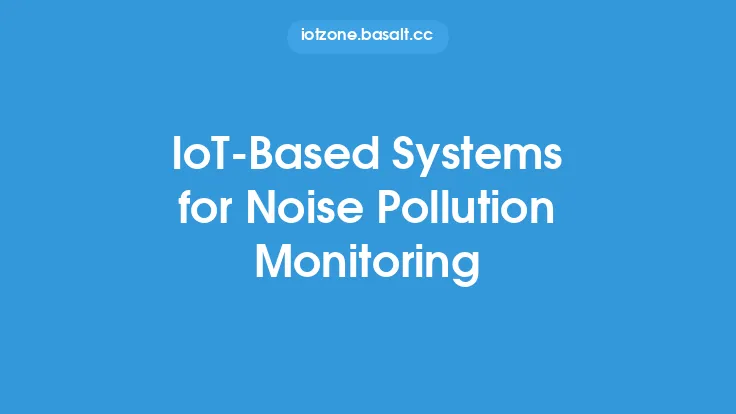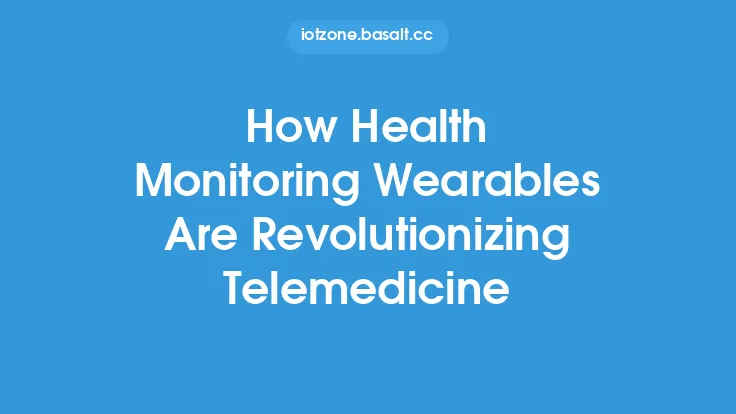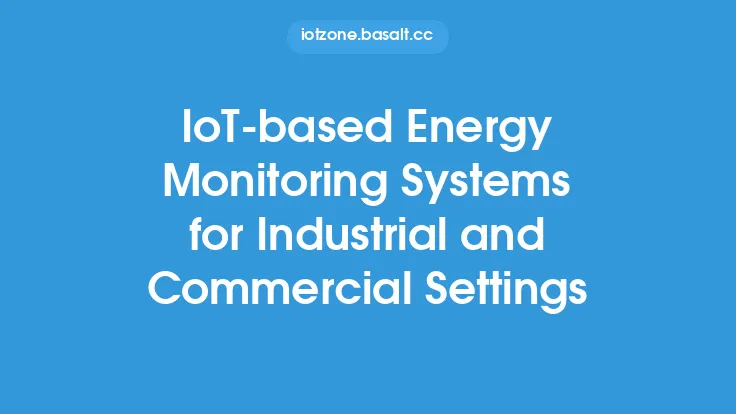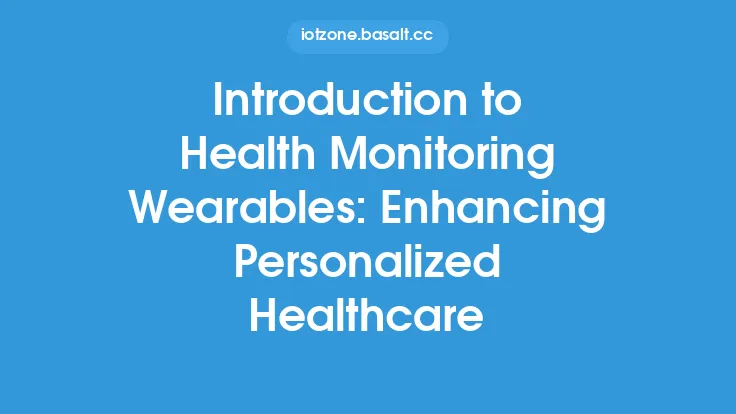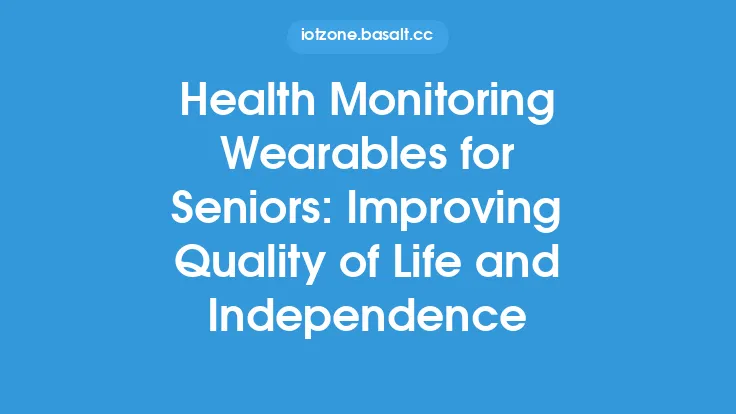The integration of Internet of Things (IoT) technology in healthcare has led to the development of remote health monitoring systems, which enable healthcare professionals to track patients' vital signs and health status in real-time, remotely. This technology has revolutionized the way healthcare is delivered, making it more accessible, efficient, and effective. Remote health monitoring systems use a combination of sensors, devices, and communication networks to collect and transmit patient data to healthcare providers, allowing for timely interventions and improved patient outcomes.
Introduction to Remote Health Monitoring Systems
Remote health monitoring systems are designed to monitor patients' health status in real-time, using a variety of sensors and devices to collect physiological data, such as heart rate, blood pressure, oxygen saturation, and body temperature. This data is then transmitted to healthcare providers through a secure communication network, allowing them to track patients' health status and respond promptly to any changes or abnormalities. Remote health monitoring systems can be used in a variety of settings, including hospitals, clinics, and patients' homes, making them a versatile and convenient solution for healthcare delivery.
Components of Remote Health Monitoring Systems
Remote health monitoring systems consist of several components, including sensors, devices, communication networks, and data analytics software. Sensors are used to collect physiological data from patients, such as electrocardiogram (ECG) sensors, blood pressure sensors, and oxygen saturation sensors. Devices, such as smartphones, tablets, or dedicated monitoring devices, are used to collect and transmit patient data to healthcare providers. Communication networks, such as cellular networks, Wi-Fi, or Bluetooth, are used to transmit patient data to healthcare providers. Data analytics software is used to analyze patient data, identify trends and patterns, and provide insights to healthcare providers.
How Remote Health Monitoring Systems Work
Remote health monitoring systems work by collecting physiological data from patients using sensors and devices. This data is then transmitted to a central server or cloud-based platform, where it is stored and analyzed using data analytics software. Healthcare providers can access patient data through a secure web portal or mobile app, allowing them to track patients' health status in real-time. If any abnormalities or changes are detected, healthcare providers can respond promptly, either by contacting the patient or by dispatching emergency services. Remote health monitoring systems can also be integrated with electronic health records (EHRs) and other healthcare systems, allowing for seamless communication and coordination between healthcare providers.
Benefits of Remote Health Monitoring Systems
Remote health monitoring systems offer several benefits, including improved patient outcomes, reduced healthcare costs, and enhanced patient experience. By enabling healthcare providers to track patients' health status in real-time, remote health monitoring systems can help prevent complications and reduce the risk of hospitalization. Remote health monitoring systems can also reduce healthcare costs by minimizing the need for hospitalizations, reducing the length of hospital stays, and decreasing the number of unnecessary medical interventions. Additionally, remote health monitoring systems can enhance patient experience by providing patients with greater control over their health, improving communication between patients and healthcare providers, and reducing the burden of frequent hospital visits.
Technical Requirements of Remote Health Monitoring Systems
Remote health monitoring systems require several technical components, including sensors, devices, communication networks, and data analytics software. Sensors must be accurate, reliable, and able to collect physiological data in real-time. Devices must be user-friendly, secure, and able to transmit patient data to healthcare providers. Communication networks must be secure, reliable, and able to transmit patient data in real-time. Data analytics software must be able to analyze patient data, identify trends and patterns, and provide insights to healthcare providers. Additionally, remote health monitoring systems must comply with regulatory requirements, such as the Health Insurance Portability and Accountability Act (HIPAA), to ensure the security and confidentiality of patient data.
Security and Privacy Considerations
Remote health monitoring systems must ensure the security and privacy of patient data, which is a critical component of healthcare delivery. Patient data must be encrypted, both in transit and at rest, to prevent unauthorized access. Remote health monitoring systems must also comply with regulatory requirements, such as HIPAA, to ensure the security and confidentiality of patient data. Additionally, remote health monitoring systems must have robust security measures in place, such as firewalls, intrusion detection systems, and access controls, to prevent cyber attacks and data breaches.
Future Directions of Remote Health Monitoring Systems
Remote health monitoring systems are expected to play a critical role in the future of healthcare, as they enable healthcare providers to track patients' health status in real-time, remotely. The integration of artificial intelligence (AI) and machine learning (ML) algorithms into remote health monitoring systems is expected to enhance their accuracy and effectiveness, by enabling them to analyze patient data, identify trends and patterns, and provide insights to healthcare providers. Additionally, the use of wearable devices, such as smartwatches and fitness trackers, is expected to increase, as they provide a convenient and non-invasive way to collect physiological data from patients. The development of 5G networks is also expected to enhance the capabilities of remote health monitoring systems, by enabling faster and more reliable data transmission.
Challenges and Limitations of Remote Health Monitoring Systems
Remote health monitoring systems face several challenges and limitations, including technical issues, regulatory requirements, and patient engagement. Technical issues, such as connectivity problems, device malfunctions, and data errors, can affect the accuracy and reliability of remote health monitoring systems. Regulatory requirements, such as HIPAA, can be complex and time-consuming to comply with, which can affect the adoption and implementation of remote health monitoring systems. Patient engagement is also a critical component of remote health monitoring systems, as patients must be willing and able to use the technology and follow the recommended treatment plans. Additionally, remote health monitoring systems may not be suitable for all patients, particularly those with complex medical conditions or limited access to technology.
Conclusion
Remote health monitoring systems are a critical component of healthcare delivery, as they enable healthcare providers to track patients' health status in real-time, remotely. These systems offer several benefits, including improved patient outcomes, reduced healthcare costs, and enhanced patient experience. However, they also face several challenges and limitations, including technical issues, regulatory requirements, and patient engagement. The future of remote health monitoring systems is expected to be shaped by the integration of AI and ML algorithms, the use of wearable devices, and the development of 5G networks. As the healthcare industry continues to evolve, remote health monitoring systems are expected to play a critical role in improving patient outcomes and enhancing the overall quality of care.
